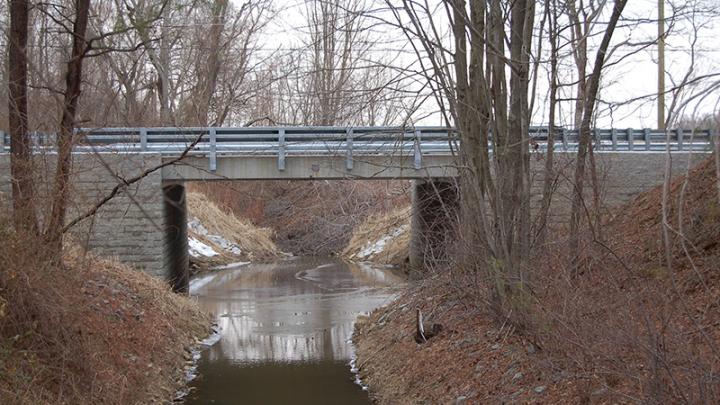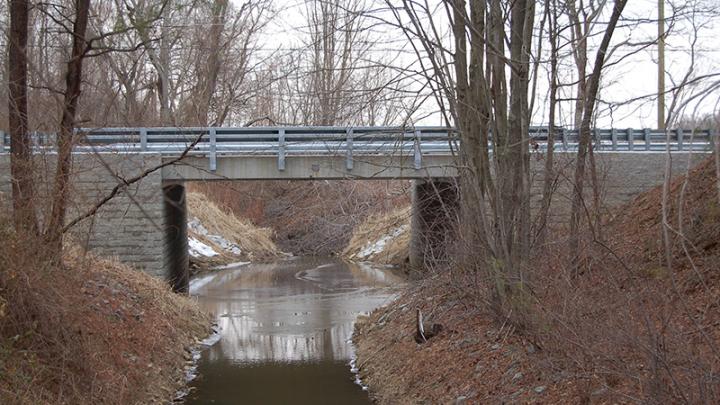
Credit: Majid Talebi/ University of Delaware
America's bridges received a grade of C+ on the 2017 Infrastructure Report Card, put out by the American Society of Civil Engineers (ASCE). Aging is a factor in this score — almost four in 10 of the 614,387 bridges in the U.S. are 50 years or older, and the average age keeps climbing.
But repair and rehabilitation are extremely costly — the most recent estimate puts the nation's backlog of bridge rehabilitation needs at $123 billion.
In 2013, the Delaware Department of Transportation decided to explore the effectiveness of a novel rapid replacement approach for a two-lane bridge just north of the C&D canal that was nearing the end of its useful service life. They collaborated with researchers at the University of Delaware on design and construction of a new bridge, which continues to be monitored via a custom-designed instrumentation system.
The old bridge was replaced with what is known as a geosynthetic reinforced soil integrated bridge system (GRS-IBS). Developed and promoted by engineers at the Federal Highway Administration, this system lends itself to rapid and cost-effective construction.
Christopher Meehan, the Bentley Systems Incorporated Chair of Civil Engineering at UD, explains that the novel design borrows from the field of retaining walls, where geosynthetic materials — including textiles, grids, strips and nets– are used to provide tensile reinforcement to soils, enhancing their overall strength and stability.
"It turns out that concepts from these technologies can also be applied to bridges, saving money and reducing construction time," Meehan says. "The new bridge is basically a composite bridge structure that incorporates GRS abutments and prefabricated bridge superstructure elements. This approach eliminates the costly downtime associated with cast-in-place concrete, which can take a few weeks to a month to cure."
For this project, the GRS abutments were constructed by laying locally available concrete masonry blocks in rows, filling behind them with gravel and covering the wall facing elements and backfill with a geosynthetic fabric. This process was repeated in layers to build each bridge abutment, and then a precast-concrete bridge superstructure was placed on top of the abutments.
Next, some finish work was performed to bring the approach ways up to the grade of the bridge, and the entire bridge and roadway area was then paved. The resulting bridge superstructure spans approximately 37 feet, with a clear span over the inlet channel of a little more than 28 feet.
The UD research team provided extensive technical support on the project, including designing and implementing a custom structural health monitoring system that comprises more than 150 sensors to continuously monitor the bridge's long-term performance.
Meehan credits graduate students Majid Talebi, Tyler Poggiogalle, Dan Cacciola and Matthew Becker with making significant contributions to the design, construction and monitoring process.
"The DelDOT journey to construct a GRS-IBS bridge actually began when Chris approached us with the idea to construct and monitor one of these innovative structures," says Barry Benton, chief bridge engineer at DelDOT and a 1992 graduate of UD in civil engineering.
"From the very inception of the project, he worked closely with us to choose a location and assist in both the design and the monitoring plan. Since this was to be the first GRS-IBS bridge in Delaware, it was very important for us to understand how it would perform."
DelDOT has since built another GRS-IBS bridge in Sussex County, which is performing well to date. Benton believes that this technology will yield the largest cost savings if an internal maintenance crew can be trained to do the work.
"The beauty of the system is that it can be constructed quickly with small equipment, so it's a perfect fit for utilizing the talents of our own staff," he says.
Meehan calls the GRS-IBS an accessible technology that can be built almost anywhere.
"Geosynthetic reinforced soil structures are well-suited for construction all over the world, as geosynthetic materials are fairly light and can be easily imported," he says.
"Beyond that point, various types of walls and bridge abutments can be constructed using locally sourced materials, with little need for cast-in-place concrete. The resulting structures are cost-effective and fairly forgiving with respect to settlement and lateral deflection, and they have been shown to perform relatively well in earthquakes."
###
Media Contact
Peter Bothum
[email protected]
302-831-1418
@UDResearch
http://www.udel.edu
############
Story Source: Materials provided by Scienmag





